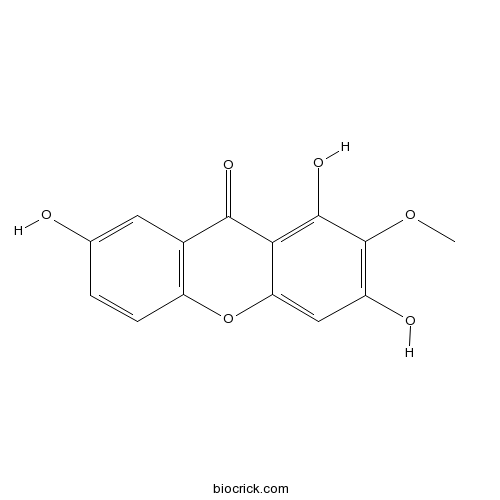1,3,7-Trihydroxy-2-methoxyxanthoneCAS# 211948-69-5 |

Quality Control & MSDS
3D structure
Package In Stock
Number of papers citing our products

| Cas No. | 211948-69-5 | SDF | Download SDF |
| PubChem ID | 12133315 | Appearance | Powder |
| Formula | C14H10O6 | M.Wt | 274.22 |
| Type of Compound | Xanthones | Storage | Desiccate at -20°C |
| Solubility | Soluble in Chloroform,Dichloromethane,Ethyl Acetate,DMSO,Acetone,etc. | ||
| Chemical Name | 1,3,7-trihydroxy-2-methoxyxanthen-9-one | ||
| SMILES | COC1=C(C=C2C(=C1O)C(=O)C3=C(O2)C=CC(=C3)O)O | ||
| Standard InChIKey | GLXRAYJUKLGHEP-UHFFFAOYSA-N | ||
| Standard InChI | InChI=1S/C14H10O6/c1-19-14-8(16)5-10-11(13(14)18)12(17)7-4-6(15)2-3-9(7)20-10/h2-5,15-16,18H,1H3 | ||
| General tips | For obtaining a higher solubility , please warm the tube at 37 ℃ and shake it in the ultrasonic bath for a while.Stock solution can be stored below -20℃ for several months. We recommend that you prepare and use the solution on the same day. However, if the test schedule requires, the stock solutions can be prepared in advance, and the stock solution must be sealed and stored below -20℃. In general, the stock solution can be kept for several months. Before use, we recommend that you leave the vial at room temperature for at least an hour before opening it. |
||
| About Packaging | 1. The packaging of the product may be reversed during transportation, cause the high purity compounds to adhere to the neck or cap of the vial.Take the vail out of its packaging and shake gently until the compounds fall to the bottom of the vial. 2. For liquid products, please centrifuge at 500xg to gather the liquid to the bottom of the vial. 3. Try to avoid loss or contamination during the experiment. |
||
| Shipping Condition | Packaging according to customer requirements(5mg, 10mg, 20mg and more). Ship via FedEx, DHL, UPS, EMS or other couriers with RT, or blue ice upon request. | ||
| Description | 1. 1,3,7-Trihydroxy-2-methoxyxanthone shows different anti-oxidation activities. |

1,3,7-Trihydroxy-2-methoxyxanthone Dilution Calculator

1,3,7-Trihydroxy-2-methoxyxanthone Molarity Calculator
| 1 mg | 5 mg | 10 mg | 20 mg | 25 mg | |
| 1 mM | 3.6467 mL | 18.2335 mL | 36.4671 mL | 72.9341 mL | 91.1677 mL |
| 5 mM | 0.7293 mL | 3.6467 mL | 7.2934 mL | 14.5868 mL | 18.2335 mL |
| 10 mM | 0.3647 mL | 1.8234 mL | 3.6467 mL | 7.2934 mL | 9.1168 mL |
| 50 mM | 0.0729 mL | 0.3647 mL | 0.7293 mL | 1.4587 mL | 1.8234 mL |
| 100 mM | 0.0365 mL | 0.1823 mL | 0.3647 mL | 0.7293 mL | 0.9117 mL |
| * Note: If you are in the process of experiment, it's necessary to make the dilution ratios of the samples. The dilution data above is only for reference. Normally, it's can get a better solubility within lower of Concentrations. | |||||

Calcutta University

University of Minnesota

University of Maryland School of Medicine

University of Illinois at Chicago

The Ohio State University

University of Zurich

Harvard University

Colorado State University

Auburn University

Yale University

Worcester Polytechnic Institute

Washington State University

Stanford University

University of Leipzig

Universidade da Beira Interior

The Institute of Cancer Research

Heidelberg University

University of Amsterdam

University of Auckland

TsingHua University

The University of Michigan

Miami University

DRURY University

Jilin University

Fudan University

Wuhan University

Sun Yat-sen University

Universite de Paris

Deemed University

Auckland University

The University of Tokyo

Korea University
- BIBR-1048
Catalog No.:BCC3738
CAS No.:211915-06-9
- BIBR 953 (Dabigatran, Pradaxa)
Catalog No.:BCC2139
CAS No.:211914-51-1
- Gliclazide
Catalog No.:BCC5002
CAS No.:21187-98-4
- Flumorph
Catalog No.:BCC5467
CAS No.:211867-47-9
- Nudicaucin A
Catalog No.:BCN7842
CAS No.:211815-97-3
- 2',4',5'-Trimethoxy-2'',2''-dimethylpyrano[5'',6'':6,7]isoflavone
Catalog No.:BCN1496
CAS No.:211799-56-3
- Picroside IV
Catalog No.:BCN6533
CAS No.:211567-04-3
- Nudicaucin B
Catalog No.:BCN7843
CAS No.:211557-36-7
- WHI-P180
Catalog No.:BCC3928
CAS No.:211555-08-7
- WHI-P97
Catalog No.:BCC2056
CAS No.:211555-05-4
- WHI-P154
Catalog No.:BCC2202
CAS No.:211555-04-3
- Dalcetrapib (JTT-705, RO4607381)
Catalog No.:BCC2328
CAS No.:211513-37-0
- Vatalanib (PTK787) 2HCl
Catalog No.:BCC1111
CAS No.:212141-51-0
- Vatalanib
Catalog No.:BCC2085
CAS No.:212141-54-3
- Apparicine
Catalog No.:BCN4008
CAS No.:2122-36-3
- 5,7-Dihydroxy-3-(4-hydroxy-3,5-dimethoxybenzyl)-6,8-dimethylchroman-4-one
Catalog No.:BCN6631
CAS No.:212201-12-2
- Ipfencarbazone
Catalog No.:BCC5465
CAS No.:212201-70-2
- Ethyl 3-(3-amino-4-(methylamino)-N-(pyridin-2-yl)benzamido)propanoate
Catalog No.:BCC8971
CAS No.:212322-56-0
- TC 2559 difumarate
Catalog No.:BCC7469
CAS No.:212332-35-9
- HS 024
Catalog No.:BCC5820
CAS No.:212370-59-7
- Oxaprozin
Catalog No.:BCC9109
CAS No.:21256-18-8
- Ebracteolatanolide A
Catalog No.:BCN3773
CAS No.:212563-72-9
- Nocistatin (human)
Catalog No.:BCC5732
CAS No.:212609-11-5
- PD 198306
Catalog No.:BCC7428
CAS No.:212631-61-3
[Chemical constituents in roots of Polygala fallax and their anti-oxidation activities in vitro].[Pubmed:16110862]
Zhongguo Zhong Yao Za Zhi. 2005 Jun;30(11):827-30.
OBJECTIVE: To study the chemical constituents in roots of P. fallax and their anti-oxidation activities in vitro. METHOD: Column chromatographic techniques were employed for isolation and purification of chemical constituents of the plant. The structures were elucidated on the basis of the spectral evidence and the physical and chemical character. The isolated compounds were screened with four anti-oxidation models in vitro. RESULT: Seven xanthones, 1,7-dihydroxy-2,3-methylenedioxyxanthone (1), 1-methoxy-2,3-methylenedioxyxanthone (2), 3-hydroxy-1,2-dimethoxyxanthone (3), 1,6,7-trihydroxy-2,3-dimethoxyxanthone (4), 7-hydroxy-1-methoxy-2,3-methylenedioxyxanthone (5), 1,3-dihydroxy-2-methoxyxanthone (6) and 1,3,7-Trihydroxy-2-methoxyxanthone (7), were isolated from the roots of P. fallax. And compounds 1 - 7 showed different anti-oxidation activities in the different pharmacological models. CONCLUSION: Compounds 2, 3, 5 and 7 were isolated from this plant for the first time. Xanthones from this plant showed anti-oxidation activities. The pharmacological activities of the pure compounds from this plant were also reported for the first time.


